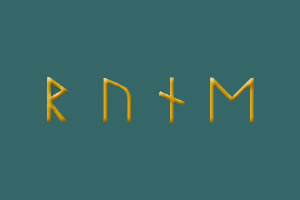Runes are letters or characters that were used by various ancient Germanic peoples, especially the Scandinavians and the Anglo-Saxons. The earliest runic inscriptions date from around 150 AD and were generally replaced by the Latin alphabet around 700 AD in central Europe and around 1100 AD in Scandinavia. The Scandinavian variants are also known as futhark, derived from their first six letters of the alphabet: F, U, Þ, A, R, and K.
Omniglot.com indicates runic inscriptions may have had various meanings: signatures on items created by woodworkers and blacksmiths; inscriptions on grave stones; religious or magic incantations; or even graffiti. But let’s pretend we’re Prospero and take a look at seven well-known runic alphabets, shall we?
- Elder Futhark: the oldest form of the runic alphabet, used by Germanic tribes from the 2nd to 8th centuries. The knowledge needed to read Elder Futhark was unknown until 1865 when Norwegian scholar Sophus Bugge deciphered the characters.
- Gothic: An extinct Germanic language, originally written with a runic alphabet, about which little is known because of the Christianization of the Goths around the mid 4th century.
- Futhorc: Used by the Anglo-Saxons and descended from the Elder Futhark; used from the fifth century onward.
- Younger Futhark: Also called the Scandinavian runes and a reduced form of the Elder Futhark, in use around 800 AD. It was the main alphabet in Norway, Sweden and Denmark throughout the Viking Age.
- Hungarian Runes (Székely Rovásírás): an Old Hungarian scriptused prior to 1000 AD. The alphabet isn't a true runic alphabet because it is unrelated to the Futhark, though the similarity of the letter shapes have led to them popularly being called "Hungarian runes.”
- Turkic (Orkhon): Used by Turkish people in the 8th century, the script gets its name from the Orkhon Valley in Mongolia. Like the “Hungarian” runes, the Orkhon script is thought of as a runic alphabet due to the similarities in shape to the Futhark.
- Cirth: Runes appear commonly in fantasy literature; in fact, the runic alphabet used by the Dwarves of Middle-earth was adapted by J.R.R. Tolkien from real-life runes. Tolkien used the Anglo-Saxon Futhorc for The Hobbit but created his own alphabet, Cirth, for The Lord of the Rings.


No comments:
Post a Comment